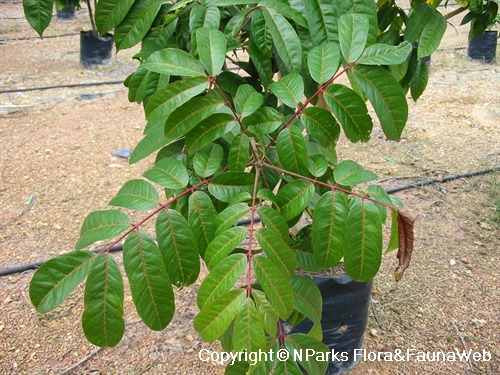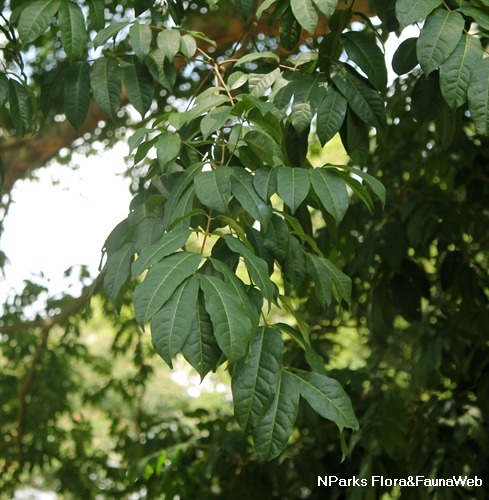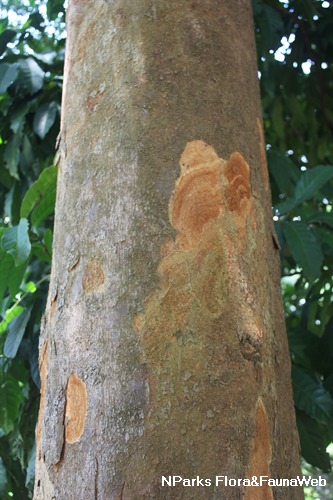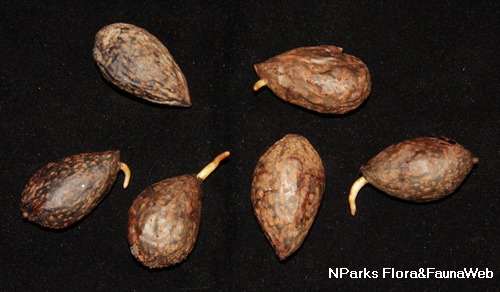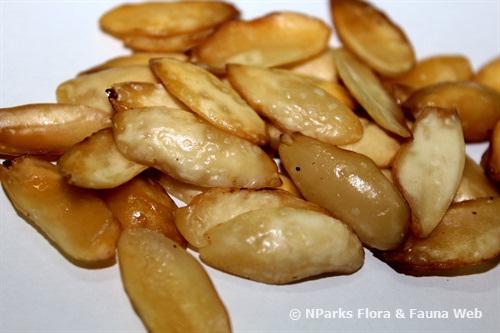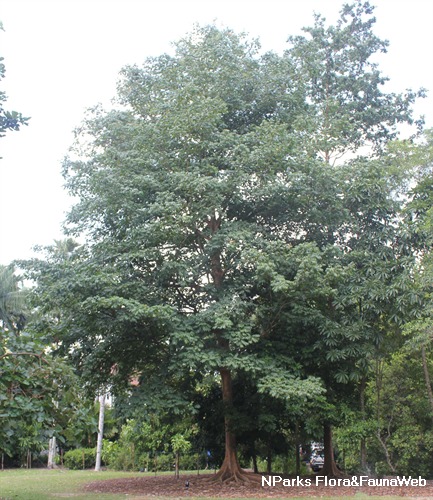
Name
Classifications and Characteristics
| Plant Division | Angiosperms (Flowering Seed Plants) (Dicotyledon) |
|---|---|
| Plant Growth Form | Tree (Big (>30m)) |
| Lifespan (in Singapore) | Perennial |
| Mode of Nutrition | Autotrophic |
| Maximum Height | 51 m |
| Tree or Palm – Trunk Diameter | 0 |
Biogeography
| Native Distribution | Peninsular Malaysia, Sumatra, Borneo, Moluccas, New Guinea, Solomon Islands. |
|---|---|
| Native Habitat | Terrestrial (Freshwater Swamp Forest, Riverine) |
| Preferred Climate Zone | Tropical |
| Local Conservation Status | Non-native (Horticultural / Cultivated Only) |
Description and Ethnobotany
| Growth Form | Large tree growing up to 51 m tall. |
|---|---|
| Trunk | The trunk width is 70 cm dbh (diameter at breast height). |
| Foliage | Alternate, pinnately compound leaves are composed of oblong leaflets with a sharply pointed tip. They usually have domatia which provide shelter for beneficial insects.The rachis (stalk of a compound leaf) is purplish red. |
| Stems | The purplish red branches are densely covered in round to linear, tan-coloured lenticels (corky structures that promote gas exchange between the tree and surrounding air). |
| Flowers | Small, star-shaped flower (0.4 cm wide) is composed of 5 white to cream-coloured petals with rounded tips. Flowers are arranged in dense, branched clusters known as panicles which have purplish red stalks. |
| Fruit | Fleshy fruits with stones are known as drupes (4 cm long). |
| Habitat | Occurs in swamps, along rivers, and areas subject to flooding. Typically found in undisturbed forest at altitudes up to 200 m. |
| Etymology | The specific epithet 'motleyi' recognizes J. Motley, a 19th century English plant collector. |
| Ethnobotanical Uses | Edible Plant Parts : Edible Fruits Food (Fruit or Vegetable): Fruits are typically eaten raw or roasted. |
Landscaping Features
| Desirable Plant Features | Ornamental Flowers |
|---|---|
| Landscape Uses | Riverine, Pond / Lake / River, Marsh / Bog |
Plant Care and Propagation
| Light Preference | Full Sun |
|---|---|
| Water Preference | Moderate Water |
| Plant Growth Rate | Moderate |
| Rootzone Tolerance | Waterlogged Soils |
| Propagation Method | Seed, Stem Cutting |
Foliar
| Mature Foliage Colour(s) | Green |
|---|---|
| Mature Foliage Texture(s) | Glossy / Shiny |
| Foliar Type | Compound (Odd-Pinnate) |
| Foliar Arrangement Along Stem | Alternate |
| Foliar Attachment to Stem | Petiolate |
| Foliar Shape(s) | Non-Palm Foliage (Obovate) |
| Foliar Venation | Pinnate / Net |
| Foliar Margin | Entire |
| Foliar Apex - Tip | Acuminate |
| Leaf Area Index (LAI) for Green Plot Ratio | 3.0 (Tree - Intermediate Canopy) |
| Prominent Young Flush Colour(s) Remarks | Orange-red, but yellowish near the midvein. |
Floral (Angiosperm)
| Flower & Plant Sexuality | Bisexual Flowers |
| Flower Colour(s) | Cream / Off-White, White |
|---|---|
| Flower Texture(s) | Smooth |
| Flower Grouping | Cluster / Inflorescence |
| Flower Location | Terminal |
| Flower Symmetry | Radial |
| Individual Flower Shape | Stellate / Star-shaped |
| Inflorescence Type | Panicle |
| Flowering Habit | Polycarpic |
| Flower Size | 0.4 cm |
Fruit, Seed and Spore
| Fruit Classification | Simple Fruit |
|---|---|
| Fruit Type | Fleshy Fruit , Non-Accessory Fruit |
| Seed Quantity Per Fruit | Few (1-5) |
Image Repository
Others
| Master ID | 1766 |
|---|---|
| Species ID | 3059 |
| Flora Disclaimer | The information in this website has been compiled from reliable sources, such as reference works on medicinal plants. It is not a substitute for medical advice or treatment and NParks does not purport to provide any medical advice. Readers should always consult his/her physician before using or consuming a plant for medicinal purposes. |

